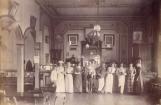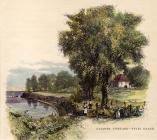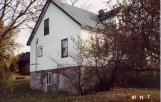1
The WineriesThe history of wine manufacturing in our region began with experimentation on the Ohio River. Within a few decades grapes were relocated to the islands of Lake Erie. Within Ontario, wine had been made since the time of the French explorer Robert de La Salle (1643-1687) who made wine from local grapes while camping on the shores of the Detroit River. It was also known that the Jesuits made wine as well as the French who settled along the Detroit River as early as the mid 1700's. Elsewhere in Ontario, Johann Schiller of Cooksville (now part of Mississauga) began fermenting grapes as early as 1811. Other early growers and wine makers in the province include those from Niagara (1857), Grimsby (1858) and Beamsville (late 1850s).
On Pelee Island the grape planting began in the 1850s with a vineyard established by Mr. Henry Price. By the 1860s wine making was established with the efforts of Thaddeus Smith, the Williams brothers and the Wardropers. These three families represented a very early commercial wine making enterprise in the province of Ontario. Soon others followed their lead, with the construction of at least six wineries on the island. These entrepreneurs spearheaded an industry which by 1890 saw the development of forty one wineries across Canada. Thirty five of those wineries were situated in Ontario and of those twenty three in the corridor between Pelee Island and Windsor.
3
Charles H. HeatonAlthough no physical evidence remains of the winery that Mr. Charles Heaton once owned, it is believed to have been located north of Mill Point on the east shore. In 1870 Heaton moved to Pelee Island from South Bass Island with his wife and four children. In the early years he practiced as a carpenter while clearing his land of woods and planting grapes. In 1898 Heaton won first prize for his dry red wine at the sixth annual Pelee Agricultural Society fair. Prior to 1905 Heaton had made wine which was marketed to Canada and the United States. Like other grape growers, Mr. Heaton pursued many types of enterprises. Fishing, cutting wood, trapping and cultivating potatoes, corn, beans and turnips as well as grapes offered Charles Heaton a means to make a living. But by 1886 Heaton sold ten acres of land to James Findlay and little else is known about Mr. Heaton's contribution to the economy of the island including the wine industry.
Henry Rehberg
Located on a ridge overlooking Lake Erie, Henry Rehberg's house-cellar finished in 1884 was described as a model of convenience, comfort and beauty, can still be seen today. Rehberg came to Pelee in the early 1880s from Middle Bass Island. His farm was described as "...in two years, has changed from an eyesore to a beauty spot, which has been further enhanced by his neatly painted buildings. He has three acres of grapes and [intends to plant] ten acres in the spring." But by the year 1888 Henry has second thoughts about remaining on Pelee. That year his farm was put up for sale comprising of sixty acres, twelve of vineyards and twenty seven of other cultivated land. The asking price was eleven thousand.
4
William Rehberg Wine Cellar and VineyardCirca 1870
Middle Bass Island, OH, United States of America
 Credits:
Credits:Charles E. Frohman Collection
R.B. Hayes Presidential Center
5
The Rehberg Family (Middle Bass Island)1892
Middle Bass Island, OH, United States of America
 Credits:
Credits:Charles E. Frohman Collection
R.B. Hayes Presidential Center
6
John FinlayIt is thought that John and his wife Alice came to Pelee in the 1870s when John purchased sixty acres of bush on East West Road. John had been living on Pelee Island for ten years before he moved from grape grower to wine maker. There is evidence of a cellar constructed for the Finlay family by 1888. The stone work of this cellar can still be seen today on East West road. The capacity of this cellar was at least ten thousand gallons. In 1893 a fire damaged the Finlay cellar; it was rebuilt in 1894 with final improvements by 1895.
8
James SrigleyMr. James Srigley arrived on Pelee Island with his wife Mary and their seven children in November 1877. As one of the larger grape growers on Pelee Island, it is possible that Mr. Srigley made wine at his farm but this is not certain. In the early years of grape growing James Srigley sold his grapes to the table market and to the Wardoper's cellar after its construction. In March 1887 Srigley's house and cellar were nearing completion. The site, offering a clear vantage in all directions, was known to locals as Rattlesnake Ridge this likely due to the suitable habitat for the now rare Massasauga Rattlesnake. In 1893 James Srigley moved to a new smaller house probably because of the growth of his son Jeremiah's family. By 1898 the farm grew to seventy acres, of which eighteen were in grapes.
10
Edward and John WardroperBy 1866 John and Edward were planting grapes, the same year as Thaddeus Smith. From the beginning the grapes were sold where the market allowed. Eventually the Wardropers found it necessary to build their own cellar. It was not until 1882 that a cellar was excavated and built beneath the house. In 1885 Edward Wardroper sold eight acre, six in grapes for eighteen hundred dollars to John Lowe. It was also in July 1885 that the two original wine families united. Edward Wardroper jr. (nephew of E. Wardroper) and Minnie Bird Smith (daughter of Thaddeus and Adelia Smith) were married. Edward Wardroper jr. was one of the last farmers to significantly expand his vineyards even in the face of declining vineyard prices
12
Thaddeus Smith and the Williams BrothersThaddeus Smith and the Williams brothers came to Pelee Island the same time as the Wardropers. In 1866 they planted twenty five acres of grapes and expanded to thirty three acres within a few years. By 1868 the house-winery was finished. The cellar was excavated in the rock with the infill limestone being used to create the walls of the structure. The style of architecture and vaults are rare for Ontario. At ground level was the winery and below, the cellar. Wine was fed by gravity from the press through holes in the vaults to the vats below. Above the winery were two stories where the Smith family lived.
In 1871 John Schulthies was brought from Kentucky to manage the Vin Villa vineyards. Born in Germany in 1812, he, his wife Katherine and their four children moved to Pelee Island before Thaddeus became sole proprietor of the business. A two story frame house was built for the family to the west of Vin Villa.
13
O'Brien, Lucius Richard, Print of water-colour etching entitled, "Catawba Vineyard-Pelee Island"19th Century, Circa 1882
Pelee Island, Ontario
 Credits:
Credits:Renate M. Sieber-Peyton
Pelee Island Heritage Museum



